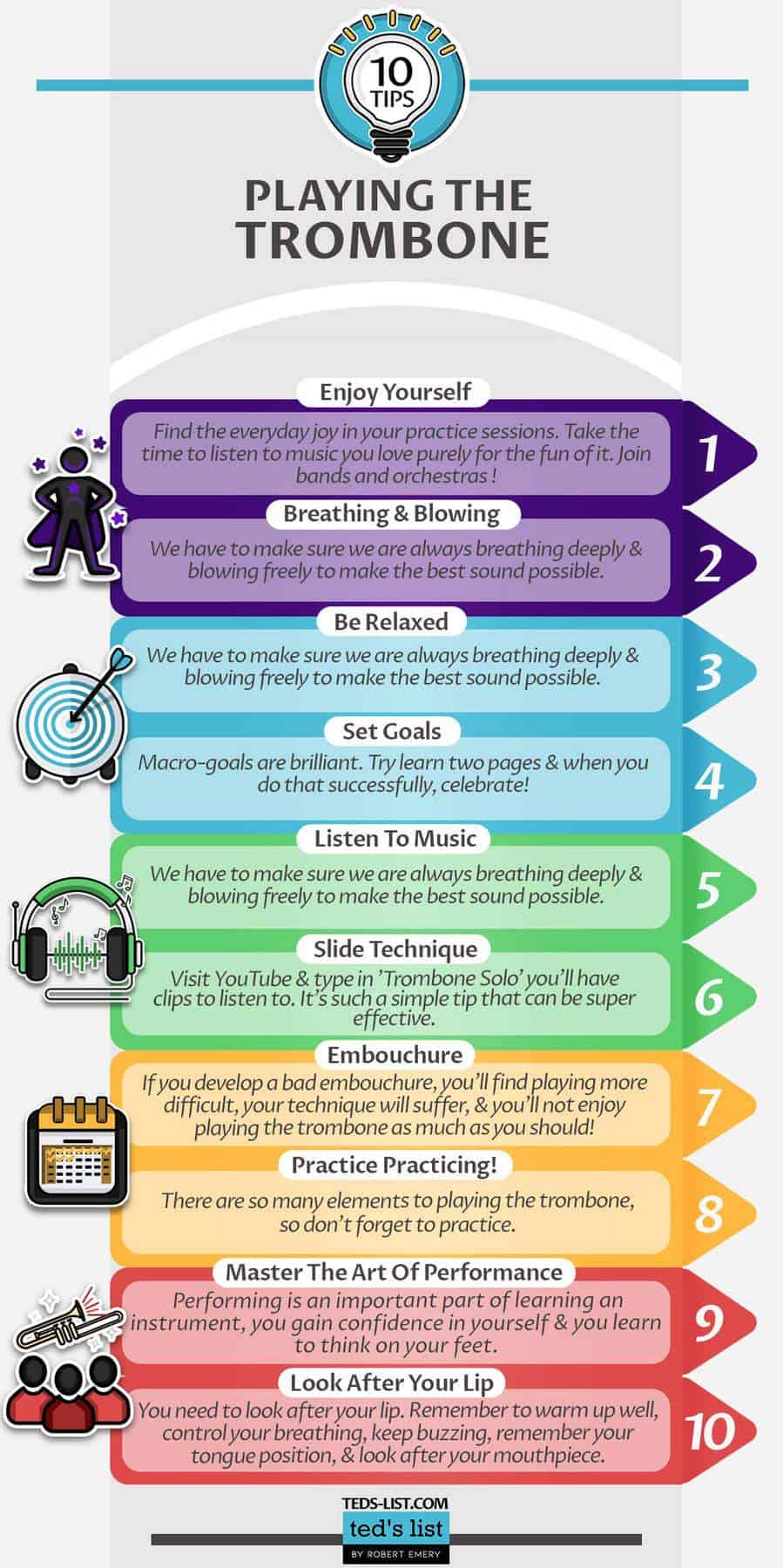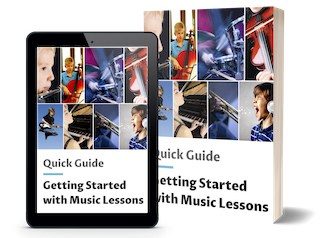Welcome to our top 10 tips for trombone players. Learning how to play the trombone has been an incredibly rewarding journey for me personally. It’s a challenging instrument, but the joy of mastering it and creating beautiful music makes it all worthwhile.
There is an awful lot to think about whilst playing an instrument, so enjoy the tips below, and remember to revisit this page regular and often.
Enjoy yourself
ONE
We often get so involved in improving and working that we can easily forget what a wonderful thing music (and playing a musical instrument) is. Find the everyday joy in your practice sessions. Take the time to listen to music you love purely for the fun of it; irrespective if it features brass instruments or not!
Join as many bands and orchestras as you can and surround yourselves with friends who love the same things you do!
Breathing and blowing is the golden rule
TWO
If the trombone is a vehicle for making music, then air is the petrol that powers it. The trombone runs off of air. We have to make sure we are always breathing deeply and blowing freely to make the best sound possible. Professional trombone players remember this every day, because if you can’t blow air, you can’t be a trombone player!
Be relaxed
THREE
Being relaxed is so important in trombone playing and other brass instruments.
As a trombone player, tension does nothing to help what is already a challenging task. When we are stressed, tension naturally creeps into our bodies and constricts everything we are trying to physically accomplish.
Take the time to shake out your arms, shoulders, neck, even your fingers. Make sure you have a good posture. Pick up the trombone in the most natural and relaxed way possible. And breath deeply without bringing tension into your neck and shoulders.
Always have a goal and a plan for reaching it
FOUR
Having a plan is vital to progression in any field of study. It is impossible to reach goals if you have not taken the time to set any for yourself. Take time to decide what kind of player you want to be. What do you do very well? What do you need to dedicate more time to?
It is also very important that you don’t make the mistake of thinking about your goals as something you are bad at. Instead, think of your goals as exciting skills that you will receive with diligent work, practice, and patience.
Think about all the small steps it will take to reach those goals and find some exercises and pieces that will help you to start taking those steps in your daily practice schedule.
Play (and listen) to as much music as possible
FIVE
Fill up your music library with new music constantly. Join every ensemble you can. Find like-minded friends and play with them! And once the instrument has left your face, listen to recordings, go to live concerts, look up who top players are from around the world and have a listen to their style of playing.
Being a musician should be fully immersive, It doesn’t stop once the case is closed. You should fill every aspect of your life with music and draw inspiration from what you find.
Slide Technique
SIX
All trombone players need to remember how important slide technique is. Remember to practice it as something separate from your embouchure exercises, and general playing. Your muscle memory for slide positions will strengthen over time, and like any good muscle, the more you exercise it, the strong it will be.
And if you need help with mutes and what to use, take a look at this great little video here…

Embouchure
SEVEN
Your embouchure forms the basis of your playing. If you develop a bad embouchure, you’ll find playing more difficult, your technique will suffer, and you’ll not enjoy playing the trombone as much as you should!
Your mouthpiece is your friend, so make sure you have a decent one that will last, and help you produce a nice tone. A cheap mouthpiece will make your life more difficult, which we absolutely do not want! Practice your mouthpiece buzzing on a daily basis to build up your muscles.
Practice Practicing!
EIGHT
There are so many elements to playing the trombone. Don’t forget to practice them all individually to improve your playing all round. Work on your slide technique as mentioned above, keep practicing long notes, work on your tongue position, do your exercise regularly, practice your breathing technique, look after your lips like all brass players have to do, work on your legato playing separately, and above all, remember to revisit these trombone tips often!
Essentially, carve out practice time in your schedule, to build on your technique and reading of trombone sheet music.
Talking about sheet music, if you need help reading the bass clef, check out this handy video we created…

Master the art of performance
NINE
We don’t all learn a musical instrument to perform in public. However, by definition, you’ll be performing to someone (even if it’s your teacher) at some point. So hold onto your nerves, focus on your playing and not ‘performing’.
Look after your lip
TEN
I know it sounds obvious, but you need to look after your lip. No lip, no playing. And yes, it sounds simple to do, but in practice, it’s not always easy. Remember to warm up well, control your breathing, keep buzzing, remember your tongue position, and look after your mouthpiece.
How to play trombone - top 10 tips
Summary
Do you want to share this infographic on your site? Use this code...
FAQ's
To play higher on the trombone, you need to have a strong embouchure and lip, you need to be breathing well, and practice playing your long notes. All trombonists struggle at the start playing high notes, so don’t worry – you’ll get there.
Learning how to practice the trombone effectively is an art in itself. The overall suggestion is to treat all the individual elements separately in your practice session. Work on things like your embouchure, your slide technique and position, tongue placement, note intonation etc. And keep on buzzing regularly to help strengthen your lip muscles.
The most standard high note is F5 – although some professional players can play a little higher than this.
All trombones players at some point need to improve their tone. You can do this by firstly practicing your embouchure, and making sure your tongue position is correct. Your lips are the link between you and your instrument, so keep working on your technique, have a steady air flow, keep working on your buzzing, and work on your slide placement. It’ll all help improve your playing and tone.
To slur on trombone, start by playing a note with a clear, focused tone. Then, smoothly and quickly slide your slide to the next note without tonguing or interrupting the airflow.
To trill on trombone, rapidly alternate between two adjacent notes by quickly moving your slide back and forth. Use your tongue to articulate each note clearly and maintain a consistent airflow.













As a parent trying to support my child’s new hobby, this article provided a lot of insight. I’m curious about the embouchure section. How early in their learning process should children focus on it? I worry about overwhelming them with too many technical aspects. What’s a good balance?
Started learning trombone to jazz up my mid-life crisis. Thanks to tips like ‘enjoy yourself’ and ‘look after your lip’, I’m not just playing music; I’m orchestrating my own renaissance, one slide at a time. Who knew a lip workout could lead to an existential glow-up? Slide technique? More like life technique. Matthew , you’re not just teaching music; you’re preaching the gospel of groove.
Love this attitude, Phil_B! Keep at it, and you’ll master not just the trombone, but the art of living vibrantly.
Phil_B, that’s the spirit! Trombone players are the alchemists of the music world, turning breath into gold. Keep sliding into that groove!
Playing and listening to as much music as possible has really improved my ability to understand how the trombone fits into different genres. I’ve found jazz and classical music to be incredibly enriching.
love this! always wanted to get better at trombone for my ska band. this helps a lot!!
Yo this is gold for someone like me in band. Slide tech is where I wanna improve, thx Matthew Gee
Excellent rundown, Matthew Gee. I’m always looking for resources to share with my students who are just beginning their journey with the trombone. I particularly found your points on embouchure and breathing techniques insightful and will be referencing your guide in my upcoming classes.
Loving the tips, especially on slide technique! Quick q, do you have any specific exercises for mastering fast slides without getting sloppy? Also, what’s your take on dry vs. wet lubrication for the slide?
Hey MelodyHarper, not Matthew Gee here, but I got some input. For fast slides, practice glissando exercises starting slow then gradually increasing speed. Also, I personally prefer a wet lubrication; it tends to give a smoother slide action while playing fast sequences.
Hey Matthew Gee, you mentioned ‘Slide Technique’ and I’m curious how different it is from playing bass guitar, which I’m more familiar with. Is it more about the finesse or do ya have to have a strong grip?
I moved from trumpet to trombone and found the slide technique quite unique. It feels a bit more fluid than strumming or plucking.